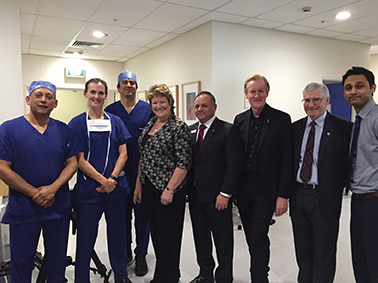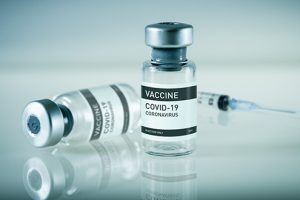In the first of a new ‘Science Series’ in IMT, Valerie Ryan interviews the Director of the St Vincent’s Hospital Heart Lung Transplant Unit in Sydney, Australia, Prof Peter Macdonald, on their cardiac transplantation using the ground-breaking ‘Heart in a Box’.

A/Prof Kumud Dhital and Prof Peter Macdonald at a media conference held with New South Wales Health Minister, Mrs Jillian Skinner, to announce that the St Vincent’s Hospital Heart Lung Transplant Unit had carried out the world’s first distant procurement of hearts donated after circulatory death (DCD). Left to right: A/Prof Kumud Dhital, the lead cardiothoracic surgeon who performed the transplants, and members of the team; Dr Emily Granger; Dr Paul Jansz; Minister Jillian Skinner; A/Prof Anthony Schembri; A/Prof Phillip Spratt; Prof Peter Macdonald, Director of St Vincent’s Hospital, Heart Lung Transplant Unit; and Dr Arjun Iyer
In a world first, Associate Professor Dr Kumud Dhital and his heart transplant team colleagues in Australia have performed three transplants using DCD (donation after circulatory death) hearts, retrieved from long distances, and restarted before being transported by air to St Vincent’s Hospital, Sydney — a feat made possible by means a of a portable organ care system and a new preservative.
Almost 50 years since the first human-to-human heart transplant, the surgeons have carried out three successful ‘dead heart’ donor transplants up to four hours after retrie-val. The latest breakthrough has been achieved by a team from Sydney’s St Vincent’s Hospital, in collaboration with the Victor Chang Cardiac Research Institute.
Just before Christmas 1967, Prof Christiaan Barnard performed the first human-to-human heart transplant using a dormant DCD heart rushed from a cadaver in the next room to the operating theatre in South Africa.
The critical difference almost 50 years later has been the distance between the donors and the recipients in the latest series of transplants. The Australians have pioneered the first long-distance organ retrieval heart transplants using the ‘Heart in a Box’ care system to restart and assess the function of the heart and — critically — by developing a new preservative solution to protect the heart during transport. Furthermore, they have extended the viability of a ‘dead heart’ to over 30 minutes after circulatory death, and achieved a four-hour window for the procedure to be completed.
This contrasts with conventional transplants, where the heart is still beating at the point where brain death is determined, and the donor organ is rushed to a transplant unit in a race against time with no way of assessing their suitability.
With concerns of potential myocardial injury once a heart is removed from its blood supply, and subsequent graft failure, the use of DCD donor hearts with current cold preservation techniques has not been considered feasible up to now. Nevertheless, the use of DCD organs is making an impact and benefiting transplantation programmes for other solid organs such as kidney, liver and lungs.
The breakthrough in transplantation using hearts from DCD donors has been achieved on foot of an extensive research programme at the Sydney facilities. “Our research into donor heart preservation goes back 20 years. Our research on recovery of hearts from DCD donors goes back five years, but this work built on our earlier work,” the medical director of the Heart Lung Transplant Unit at St Vincent’s Hospital, Prof Peter Macdonald, told Irish Medical Times.
The lead cardiothoracic surgeon was A/Prof Kumud Dhital, however, the pioneering programme has been achieved through the work of a large clinical and laboratory research team, including one Irish member on the laboratory research team that focuses on the organ preservation research.
Prof Macdonald explained the numbers involved: “Overall about 30 people are ‘activated’ during the transplant process. Usually, we are transplanting hearts and lungs from the same donor into separate recipients.”
‘Priming’ solution
Once the heart has stopped beating and death has been determined, the approach during transplantation begins with removing blood from the donor. “Approximately 1.5 litres of donor blood is removed. This is the first step. It is added to 0.5 litre of a ‘priming’ solution that was developed by TransMedics.
“We have developed a special flush solution which is administered to the donor heart while still in the donor. The preservation solution is only administered after the heart has stopped beating and death has been determined,” he added.
And on the question of cooling the heart, Prof Macdonald explained that the preservation solution that was administered was kept on ice until administration. “We administer one litre of this cold preservation solution, which cools the heart to about 4oC.” Once the heart is removed, he added, there is a “disposable sterile heart chamber”, which was connected to the perfusion circuit. “The heart is connected to a perfusion cannula within the sterile chamber.”
The role of organ preservation solutions has come under the spotlight in recent years as transplant units search for donor organs from centres further and further afield. While the success of the Australian programme has hinged on a number of factors, not least of these was the new preservation solution they pioneered to protect the DCD heart, and to allow sufficient time for safe transport from the point of retrieval until the transplant is carried out.
What does the new preservative contain? EPO? Gylceryl trinitrate? “The preservation solution does contain glyceryl trinitrate and erythropoietin. There is a third reagent that we believe will further protect the donor heart, but it is not available/approved for human administration.
In addition, for human administration we have used St Thomas’ solution instead of Celsior. The manufacturer of the TransMedicsTM OCS has a specific recommendation against the use of Celsior or Viaspan with the OCS although, we think this recommendation is unwarranted based on our laboratory research,” added Prof Macdonald.
All this is clearly critical to maintaining the condition of the heart, but is the preservative solution flushed away before the heart is transplanted into the recipient? According to Prof Macdonald, the preservation solution is flushed away with the blood/priming solution before being placed on the machine. And while in the portable organ care system he added: “The heart is perfused with an oxygenated mixture of donor blood and priming solution.”
Cold ischaemia
The stated aim of the new technique is to limit the detrimental effects of cold ischaemia — the period where the heart is without oxygen and nutrients — that occurs with the standard organ preservation mode, where the heart is packed on ice in an Esky.
The technology used to transport the donor hearts was in the form of an ex vivo Organ Care System from the company, TransMedics (OCS — TransMedicsTM Heart technology). The portable system is designed to carry organs in the nearest physiologic and functioning state outside of the human body as possible, from the time the organ is removed from the donor until its ready to be transplanted into a suitable recipient.
The team says they can tell quite reliably whether the DCD heart is suitable for transplant based on the performance of the heart on the machine. A WiFi monitoring system allows the biomedical, mechanical and chemical parameters to be assessed continually until the organ is transplanted.
TransMedics say their system minimises cold ischaemia injury by perfusing the heart with warm oxygenated blood; it optimises the condition of the organ by replenishing oxygen, nutrients, and hormones that would otherwise become depleted and provides continuous monitoring and assessment of the heart until the point of transplantation.
Worldwide figures from the registry of the International Society for Heart and Lung Transplantation show declining numbers of heart transplants which have platea-ued at around 4,000, but the Australians believe this latest development will result in 30 per cent more lives being saved using the new technique by increasing the pool of viable donors.
They say organ donation is a very rare event at present — only about 1 per cent of deaths occur in circumstances which allow organ donation to take place.
New South Wales Health Minister Mrs Jillian Skinner met the two patients with end-stage heart failure who became the first distantly procured DCD heart transplant recipients in October, when they faced the world’s media. Michelle Gribilas, a Sydney woman, who received the first DCD donor heart in August 2014, was followed by carpenter Jan Damen and a third patient.
Just before Christmas 1967, Christian Barnard performed the first human-to-human heart transplant and used a DCD heart from a cadaver in the next room to the operating theatre in South Africa. Only a year later, Prof Barnard arrived at Dublin Airport to be met by the late editor of the Irish Medical Times, Dr John O’Connell, who had arranged the visit.
Prof Barnard was here to speak on his groundbreaking work on cardiac transplantation at the Royal College of Surgeons in Ireland.
Almost 50 years on and cardiothoracic surgeons in Australia have returned to the use of DCD donor hearts, and carried out three successful transplants from DCD donors, a significant event which also marks the 30th anniversary of the St Vincent’s Heart Lung Transplant Unit and the 20th anniversary of the Victor Chang Institute this year in 2014.
• The MSD Science Series is an educational initiative that provides high-quality, balanced science information to Irish healthcare professionals and reflects MSD’s commitment to innovation, research and scientific discovery.
• All MSD Science Series articles are developed in partnership with independent specialists and contributors. The MSD Science Series is provided as a service to the Irish medical community by MSD in Ireland.
• The views expressed are solely those of the author(s) and in no way may be deemed to reflect the views or policy of either MSD Science Series or MSD.
 Irish Medical Times Medical News for Healthcare Professionals
Irish Medical Times Medical News for Healthcare Professionals







